Notes: Barnoldswick station was the terminus of the single-track branch from Earby. It was provided with a single platform on the south-west side of the line with stone and timber buildings on the platform. The stone building was the original Barnoldswick Company’s booking office, the wooden buildings being added in two stages by the Midland Railway. The first of these, at the south end of the original building, had a narrow canopy and comprised waiting rooms and an external gents' toilet. A goods office was provided in 1904 at the north end of the building. The canopy was later extended in front of this building and the booking office. At the south end of the platform there was a swan-necked water crane, originally fed from a large water tank in the coal yard but later connected to the town supply.
A level crossing at the north end of the platform allowed trains to cross Station Road to reach the coal yard. There was no ramp at this end of the platform, only steps which gave access to the level crossing. The level crossing was also used by passenger trains so that the locomotive could run round its coaches; the gates were opened and closed by hand. It was unusual in that, when closed against the railway, both gates swung to cover the platform side, the goods yard being left unprotected.
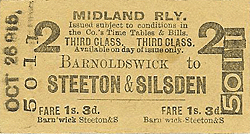 The main goods yard was opposite the platform. The yard comprised four sidings entered from the run-round loop. One siding ran to an end-loading dock adjacent to the crossing; another passed through a large wooden goods shed with an awning over the adjacent siding. The shed was not built to a standard Midland Railway design and was probably designed and built by a local contractor. The Summary Book mentions that grain (from the local corn mill) was diverted in 1897 due to 'insufficient warehouse accommodation'. As a result, the goods shed was extended c1904. A 5-ton crane stood between these two sidings. The third siding stopped short of the goods shed, and the fourth extended past the goods shed almost to Wellhouse Road.
There was a stone platelayers' hut at the throat of the goods yard. The main goods yard was opposite the platform. The yard comprised four sidings entered from the run-round loop. One siding ran to an end-loading dock adjacent to the crossing; another passed through a large wooden goods shed with an awning over the adjacent siding. The shed was not built to a standard Midland Railway design and was probably designed and built by a local contractor. The Summary Book mentions that grain (from the local corn mill) was diverted in 1897 due to 'insufficient warehouse accommodation'. As a result, the goods shed was extended c1904. A 5-ton crane stood between these two sidings. The third siding stopped short of the goods shed, and the fourth extended past the goods shed almost to Wellhouse Road.
There was a stone platelayers' hut at the throat of the goods yard.
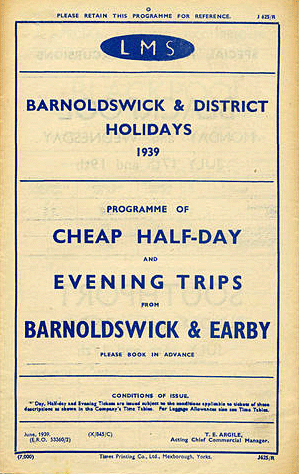
To the south of the station, the line ran under Bridge No.10 (Rainhall Road) and entered a cutting with a crossover to the main line and the start of a long headshunt. The crossover was controlled by a two-lever ground frame, open to the elements and unlocked by the key on the end of the branch staff. The headshunt was also used for storing the branch passenger stock. Bridge No. 9 (Rook Street) crossed both the running line and the headshunt.
The goods shed was demolished in the early 1950s. The line to the loading dock was retained, as was the long siding, but the other two were lifted. In the early 1960s the long siding was used for the storage of surplus suburban coaching stock.
At one time a large iron water tank on wooden legs stood in the coal yard adjacent to Station Road and next to the level crossing; this is shown on the 1920 OS map but not on earlier maps. A small collection of coal merchants’ offices stood just inside the double entrance gates where there was a weighbridge on an area that was part covered in stone setts.
The 1894 Ordnance Survey map (reproduced below) shows the coal yard to have been very short with a total of four sidings, none of them over 100ft in length, the total capacity being 20 wagons. Towards the end of the nineteenth century about 9,000 tons of coal were being handled each year. The 1909 map shows that three of the sidings had been doubled in length (in 1907) and the yard was now handling 18,000 tons of coal per year. The sidings were extended again in 1913 as near as they could be to Skipton Road. This extension was built on an embankment, and advantage of this was taken to build coal drops with road access from Skipton Road. The yard was now handling 33,000 tons of coal a year. A ground frame in a standard Midland Railway hut was sited just inside the goods yard near the level crossing but on the opposite side of the tracks to the coal offices.
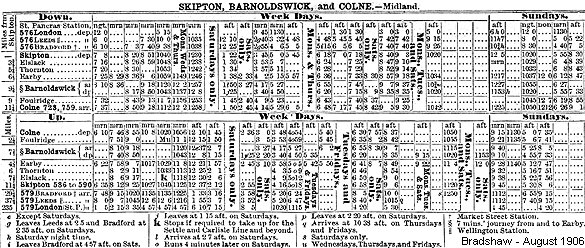 |
A one-road engine shed with an adjacent water column was built at the back of the coal yard by 1880; it was a sub-shed to Skipton. The shed had closed by July 1912 to make way for extra coal sidings; it was demolished the following year. The coal yard was one of the few places where the Midland Railway officially allowed its locomotives to tow wagons on an adjacent line by rope. In the 1960s the yard was still handling about five wagons of coal per day with ten on some days (about 25,000 tons a year). Despite the station's size there was never a signal box. At the end of the platform was the only signal, a single crossbar stop signal topped by a lamp. This was hand-operated from the base of the post and was not interlocked to any points or the level crossing gates. This signal, however, was seldom used especially in later years.
BRIEF HISTORY OF THE BARNOLDSWICK RAILWAY
The Leeds & Bradford (Shipley–Colne Extension) Railway Act of 30 June 1845 empowered the company to build its line as an extension of the Leeds & Bradford Railway, which was still under construction between the two urban centres. In July 1846, the company was leased to the Midland Railway, which later absorbed it on 24 July 1851.
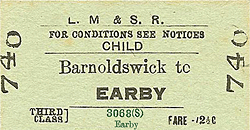 The first section of the line was from Shipley, at a triangular junction with the Leeds & Bradford Railway, to Keighley. A tender for construction was let on 15 October 1845, and the section opened on 16 March 1847. The second section, from Keighley to Skipton, opened on 7 September 1847, initially as a single track, but doubled by the end of the year. Trains ran between Bradford and Skipton; passengers to and from Leeds changed at Shipley. The first section of the line was from Shipley, at a triangular junction with the Leeds & Bradford Railway, to Keighley. A tender for construction was let on 15 October 1845, and the section opened on 16 March 1847. The second section, from Keighley to Skipton, opened on 7 September 1847, initially as a single track, but doubled by the end of the year. Trains ran between Bradford and Skipton; passengers to and from Leeds changed at Shipley.
The final section between Skipton and Colne was contracted on 9 September 1846 and opened on 2 October 1848. At Colne it was to make an end-on junction with the East Lancashire Railway's Blackburn, Burnley, Accrington & Colne Extension Railway, which did not open until 1 February 1849. By 2 April in the same year the line was part of a through route between Leeds and Liverpool, but the majority of passenger trains were local between Skipton and Colne.
Intermediate stations on this third stage were provided at Elslack, Thornton-in-Craven, Earby and Foulridge. All except Elslack opened with the line; Elslack first appeared in timetables in December 1848.
Barnoldswick dates back to Anglo Saxon times. For hundreds of years it remained a small village. However, the arrival of the Leeds & Liverpool Canal (opened in stages between 1773 and 1816), spurred the development of the existing woollen industry. As with neighbouring Skipton, it went on to specialise in cotton goods, reflecting its strong links with Lancashire – to which county Barnoldswick was transferred, for administrative purposes, in April 1974.

Barnoldswick could have had a through station as early as 1846 if the Blackburn, Clitheroe & North Western Junction Railway had been built as authorised. Another proposal that failed to materialise was the Fleetwood, Preston & West Riding Junction Railway which would have passed through Barnoldswick to a junction with the Shipley - Colne extension line at Elslack. Frustrated by the failure of proposals to build a railway to the town, local mill owners decided that the only option was to promote their own line, and formed the Barnoldswick Railway Company.
Their line was authorised by parliament on 12 August 1865, and construction started two years later. The 1 mile 1342yd single-track line opened on 8 February 1871. There were no intermediate stations on the branch. Despite a substantial cotton mill close to the railway at Salterforth no station, or even a siding, was provided there although land was acquired in case a siding was needed; it remains a mystery why this potential source of traffic was never tapped. The branch left the Leeds & Bradford Extension Railway at Barnoldswick Junction 55 chains south of Earby station. The line through the junction was on a curve of 20 chains radius, after which it converged to a single track and ran in a straight line to Barnoldswick. In order to follow this straight course there were extensive earthworks for much of its length, with cuttings and embankments and a substantial iron bridge over the Leeds & Liverpool Canal. The line was worked by the Midland Railway from the start.
The passenger shuttle between Barnoldswick and Earby was known locally as the 'Barlick Spud' or 'Spudroaster'. The real reason for the name is lost in time, but two versions that were commonly recited are that the original branch locomotive was so small that it looked like a portable potato roaster used by a local vendor, and that the journey time was the same as that taken to roast a potato in the locomotive's firebox. (‘Barlick’ is still the normal local pronunciation of the town’s name.)
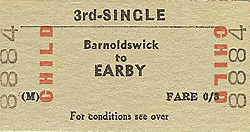 The 1881 timetable shows that all trains were ‘mixed’, i.e. composed of both passenger and goods stock. At that time, eight daily trains ran in each direction with no Sunday service. The first train left Barnoldswick at 7.35am and arrived at Earby at 7.43am; the last left Earby at 6.50pm and arrived at Barnoldswick at 7.00pm. The locomotive for these trains was shedded at Barnoldswick where a single-road shed was opened in about 1880; it was in the coal yard north of the station on the other side of Station Road. Advertised excursions at this time show trains running from Barnoldswick to Leeds (en route to Scarborough) and back. Also the L&YR ran excursions from Barnoldswick to Colne (en route to Blackpool) and back. In March 1898 the Barnoldswick Railway proposed to sell the line to the Midland Railway. As the branch had always paid a regular and reasonable dividend the Midland obtained powers to purchase the branch in 1899 and, having taken control, soon completed improvements and extensions which had been desperately needed. The 1881 timetable shows that all trains were ‘mixed’, i.e. composed of both passenger and goods stock. At that time, eight daily trains ran in each direction with no Sunday service. The first train left Barnoldswick at 7.35am and arrived at Earby at 7.43am; the last left Earby at 6.50pm and arrived at Barnoldswick at 7.00pm. The locomotive for these trains was shedded at Barnoldswick where a single-road shed was opened in about 1880; it was in the coal yard north of the station on the other side of Station Road. Advertised excursions at this time show trains running from Barnoldswick to Leeds (en route to Scarborough) and back. Also the L&YR ran excursions from Barnoldswick to Colne (en route to Blackpool) and back. In March 1898 the Barnoldswick Railway proposed to sell the line to the Midland Railway. As the branch had always paid a regular and reasonable dividend the Midland obtained powers to purchase the branch in 1899 and, having taken control, soon completed improvements and extensions which had been desperately needed.
The 1903 timetable showed an improved service with 11 trains during the week and two extra late trains on a Saturday from Barnoldswick; there were 10 during the week, with two extra late trains on Saturday, from Earby.
In May 1904, taking advantage of the 1896 Light Railways Act, the Barnoldswick and Gisburn Light Railway Company was formed. This company attempted to obtain powers to build a 3¾-mile single-track line from Barnoldswick to connect with the Lancashire & Yorkshire Railway’s Chatburn to Hellifield line just north of Gisburn. As the L&YR refused to allow a junction near Gisburn the scheme was abandoned. A similar scheme, put forward in 1913 - but without a connection to the L&YR - failed owing to the Great War.
The 1911 timetable shows a more frequent, but complicated, service with most trains running as passenger only, the actual number of trains varying with the day of the week. Two trains ran each way as ‘mixed’, and there were two goods trains to, and three from, Barnoldswick. On Sundays there were five passenger and two mixed trains to Barnoldswick.
On 16 November 1922, after numerous complaints from passengers, steam heating equipment was fitted to the two locomotives and nine carriages allocated to the branch. This was 20 years after the Midland Railway had fitted steam heating to their main line coaches.
Road transport had captured a large slice of the market well before WW1 but the service was retained and improved in an attempt to attract more passengers. By 1929 there were 16 weekday departures plus a train which ran only on Tuesdays and Fridays. Following the opening of what is still known locally as the ‘new’ road, which paralleled the railway, passenger numbers soon dropped dramatically. Construction of the road started in 1922 and it was expected to be completed in two years but, after repeated delays, the first section between Salterforth and Earby opened in December 1929. This enabled Ezra Laycock to start a bus service from Barnoldswick via Salterforth to Earby.
1929 was a bad year for the railway, with bookings down to 104,638 from 116,366 in 1928, but 1930 saw a catastrophic fall to 63,608. With the completion of the road through to Kelbrook the Burnley, Colne & Nelson Joint Transport Committee buses took over the Earby route, leaving Ezra Laycock with the ‘direct’ route to Skipton. The cotton trade depression and general strike also led to a decline in goods traffic.
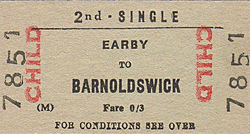 In an attempt to stem the decline, a push-and-pull service was introduced in 1932. It was uneconomical to uncouple the locomotive after each journey on such a short branch. If the locomotive remained coupled to the carriages and pulled them to Barnoldswick and then pushed them back to Earby, savings could be made. The railway also cut fares. The Craven Heraldreported on 22 July 1932 that ‘contrary to the practice of recent years, Barnoldswick people had used the railway as the chief mode of transit throughout the holiday week’. This had been due to cheaper rates; fares for Blackpool, Morecambe and Southport had been reduced considerably. Many people had taken advantage of the new 15 shilling (75p) tourist ticket extending over the full week. In an attempt to stem the decline, a push-and-pull service was introduced in 1932. It was uneconomical to uncouple the locomotive after each journey on such a short branch. If the locomotive remained coupled to the carriages and pulled them to Barnoldswick and then pushed them back to Earby, savings could be made. The railway also cut fares. The Craven Heraldreported on 22 July 1932 that ‘contrary to the practice of recent years, Barnoldswick people had used the railway as the chief mode of transit throughout the holiday week’. This had been due to cheaper rates; fares for Blackpool, Morecambe and Southport had been reduced considerably. Many people had taken advantage of the new 15 shilling (75p) tourist ticket extending over the full week.
By 1934 the weekday departures had risen to 24 with a number of through services to Skipton, Colne and Burnley. Sunday evenings saw nine trains running, but none during the day. This new-found popularity was to be short-lived; by 1939 the branch service operated on weekdays only. Post war shortages of coal, steel and labour and a shortage of capital inevitably led to a further run down in services. The number of passenger trains was reduced until by 1956 it was down to about 12 per day. From September 1956, however, it was drastically cut to one on Monday - Friday, the 4.30 from Skipton (for school children). On Saturdays it was the 11.45 from Earby. The stock was then left at Barnoldswick for the following Monday morning train and the loco went back light engine or with empty wagons to Skipton. Outwards the 8.19 am ran Monday - Saturday and the 5pm was Monday - Friday only. So the service was two on Monday - Friday and one on Saturday plus a single mid-day goods train. That was the pattern maintained until the passenger service was withdrawn. The afternoon service was provided by a DMU from 1959 but the morning service remained steam-hauled until closure.
The passenger trains were mainly for pupils at Ermysted's Grammar School and the Girls’ High School, both in Skipton. The termination of these trains saw the last of any significant passenger numbers using the station. Excursion trains to the seaside and special trains for Skipton Gala were still run but had little or no advertising.
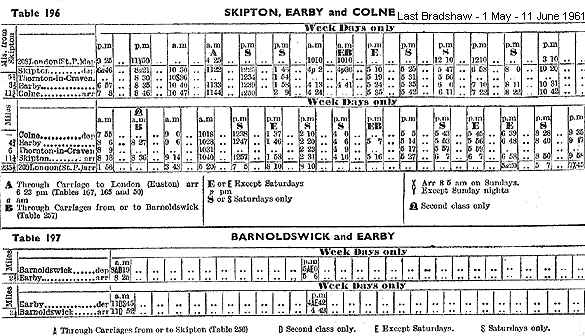 |
Despite its minimal passenger train service BR installed ‘totem’ signage at Barnoldswick station after 1956, but gas lighting was retained. Earby also received totems, but curiously they were wooden; it has been suggested that they were unofficial, locally-made signs, produced because the Earby staff felt that their station deserved them.
The Reshaping of British Railways (‘Beeching’) report of March 1963 recommended the closure to passengers of the Barnoldswick branch, but not the Skipton – Colne line, although services were reduced on the latter route. On 4 September 1964 withdrawal of the Earby – Barnoldswick service was officially proposed. Although closure had not yet been sanctioned, school season tickets were withdrawn and the local authorities were forced to provide road transport for the hundreds of children who attended schools in Skipton and Keighley each day. A solitary dirty coach was provided for the now almost empty morning train until closure proposals were approved by the Minister of Transport on 19 July 1965, which took effect on Monday 27 September 1965, the final passenger train having run the previous Saturday. The last coal train ran used the branch on 30 July 1966.
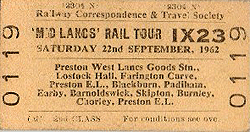 The Skipton - Colne line was indicated as part of the ‘network for development’ in March 1967, and would be the only passenger line retained to Skipton if the proposal had been followed. However the plan was reconsidered in favour of retaining the trains between Skipton and Leeds/Bradford – today an electrified commuter line with an intensive service – and, for the time being, continuing to operate trains between Skipton and both Carlisle and Lancaster as well. The closure of the Skipton to Colne route was published on 20 December 1968 and approved by the Minister of Transport on 19 December 1969; closure to passengers swiftly followed on 2 February 1970. Colne is now the terminus of the East Lancashire Line with trains running from Blackpool South run through Preston and Blackburn to Burnley and Colne. The removal of the eleven miles between Skipton, Earby and Colne is generally regarded as one of the less intelligent closure decisions, and there has long been an animated campaign to reinstate the line. The Leeds to Skipton route is part of the ‘Airedale Line’, also used by trains on the Leeds-Morecambe and Leeds, Settle and Carlisle services. The Skipton - Colne line was indicated as part of the ‘network for development’ in March 1967, and would be the only passenger line retained to Skipton if the proposal had been followed. However the plan was reconsidered in favour of retaining the trains between Skipton and Leeds/Bradford – today an electrified commuter line with an intensive service – and, for the time being, continuing to operate trains between Skipton and both Carlisle and Lancaster as well. The closure of the Skipton to Colne route was published on 20 December 1968 and approved by the Minister of Transport on 19 December 1969; closure to passengers swiftly followed on 2 February 1970. Colne is now the terminus of the East Lancashire Line with trains running from Blackpool South run through Preston and Blackburn to Burnley and Colne. The removal of the eleven miles between Skipton, Earby and Colne is generally regarded as one of the less intelligent closure decisions, and there has long been an animated campaign to reinstate the line. The Leeds to Skipton route is part of the ‘Airedale Line’, also used by trains on the Leeds-Morecambe and Leeds, Settle and Carlisle services.
Barnoldswick station was subsequently demolished shortly after closure, a supermarket and car park being built on the site. The coal yard is now landscaped and a new road built across it. The goods yard wall is still standing and is the car park boundary. The platform retaining wall can be seen down the side of the supermarket. Above this wall the former stationmaster's house, built by the LMS, is still occupied. The town war memorial was moved from Letcliffe Park and onto the area of the platform gates. Today the line can still be followed for much of its course to the outskirts of Barnoldswick although the course is lost through Salterforth.
Tickets from Michael Stewart, Bradshaws from Chris Hind and Chris Totty, Totem from Richard Furness, route map drawn by Alan Young.
Click here for details of a commemorative set of 6 colour postcards of the Barnoldswick - Earby Railway produced for the 30th anniversary of closure in 1995 - £1.75 per set
Click here to see of a 6 minute film with includes a journey from Earby to Barnoldswick
Click here for Ted Harrison's memories of his time at Barnoldswick station in the 1940s
Sources:
See also: Foulridge, Earby, Thornton-in-Craven
& Elslack |

old1.jpg)

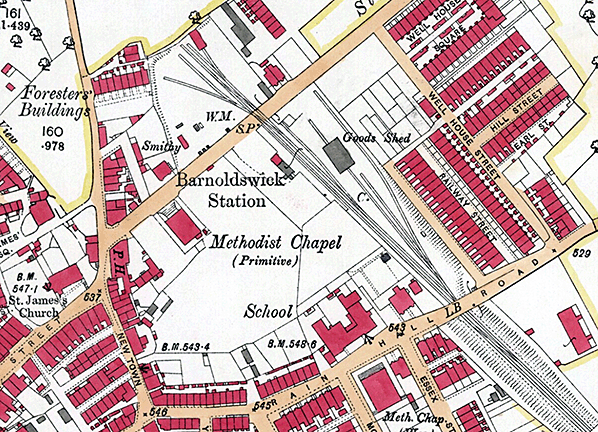
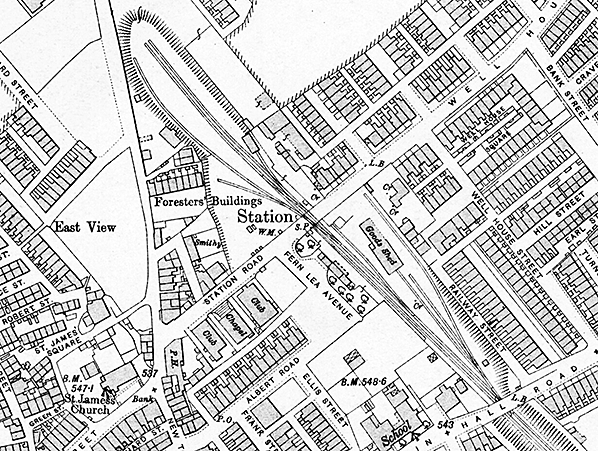
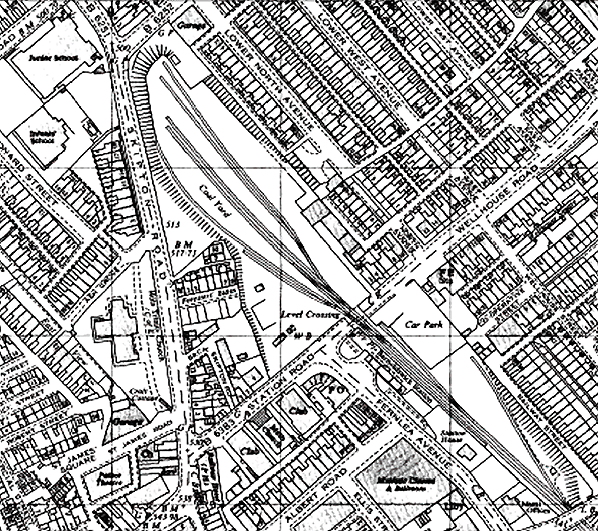
old18.jpg)
old2.jpg)
old22.jpg)
old24.jpg)
old17.jpg)
old20.jpg)
old27.jpg)
old19.jpg)
old30.jpg)
old31.jpg)
1.jpg)
4.jpg)

 The main goods yard was opposite the platform. The yard comprised four sidings entered from the run-round loop. One siding ran to an end-loading dock adjacent to the crossing; another passed through a large wooden goods shed with an awning over the adjacent siding. The shed was not built to a standard Midland Railway design and was probably designed and built by a local contractor. The Summary Book mentions that grain (from the local corn mill) was diverted in 1897 due to 'insufficient warehouse accommodation'. As a result, the goods shed was extended c1904. A 5-ton crane stood between these two sidings. The third siding stopped short of the goods shed, and the fourth extended past the goods shed almost to Wellhouse Road.
There was a stone platelayers' hut at the throat of the goods yard.
The main goods yard was opposite the platform. The yard comprised four sidings entered from the run-round loop. One siding ran to an end-loading dock adjacent to the crossing; another passed through a large wooden goods shed with an awning over the adjacent siding. The shed was not built to a standard Midland Railway design and was probably designed and built by a local contractor. The Summary Book mentions that grain (from the local corn mill) was diverted in 1897 due to 'insufficient warehouse accommodation'. As a result, the goods shed was extended c1904. A 5-ton crane stood between these two sidings. The third siding stopped short of the goods shed, and the fourth extended past the goods shed almost to Wellhouse Road.
There was a stone platelayers' hut at the throat of the goods yard.


 The first section of the line was from Shipley, at a triangular junction with the Leeds & Bradford Railway, to Keighley. A tender for construction was let on 15 October 1845, and the section opened on 16 March 1847. The second section, from Keighley to Skipton, opened on 7 September 1847, initially as a single track, but doubled by the end of the year. Trains ran between Bradford and Skipton; passengers to and from Leeds changed at Shipley.
The first section of the line was from Shipley, at a triangular junction with the Leeds & Bradford Railway, to Keighley. A tender for construction was let on 15 October 1845, and the section opened on 16 March 1847. The second section, from Keighley to Skipton, opened on 7 September 1847, initially as a single track, but doubled by the end of the year. Trains ran between Bradford and Skipton; passengers to and from Leeds changed at Shipley.

 The 1881 timetable shows that all trains were ‘mixed’, i.e. composed of both passenger and goods stock. At that time, eight daily trains ran in each direction with no Sunday service. The first train left Barnoldswick at 7.35am and arrived at Earby at 7.43am; the last left Earby at 6.50pm and arrived at Barnoldswick at 7.00pm. The locomotive for these trains was shedded at Barnoldswick where a single-road shed was opened in about 1880; it was in the coal yard north of the station on the other side of Station Road. Advertised excursions at this time show trains running from Barnoldswick to Leeds (en route to Scarborough) and back. Also the L&YR ran excursions from Barnoldswick to Colne (en route to Blackpool) and back. In March 1898 the Barnoldswick Railway proposed to sell the line to the Midland Railway. As the branch had always paid a regular and reasonable dividend the Midland obtained powers to purchase the branch in 1899 and, having taken control, soon completed improvements and extensions which had been desperately needed.
The 1881 timetable shows that all trains were ‘mixed’, i.e. composed of both passenger and goods stock. At that time, eight daily trains ran in each direction with no Sunday service. The first train left Barnoldswick at 7.35am and arrived at Earby at 7.43am; the last left Earby at 6.50pm and arrived at Barnoldswick at 7.00pm. The locomotive for these trains was shedded at Barnoldswick where a single-road shed was opened in about 1880; it was in the coal yard north of the station on the other side of Station Road. Advertised excursions at this time show trains running from Barnoldswick to Leeds (en route to Scarborough) and back. Also the L&YR ran excursions from Barnoldswick to Colne (en route to Blackpool) and back. In March 1898 the Barnoldswick Railway proposed to sell the line to the Midland Railway. As the branch had always paid a regular and reasonable dividend the Midland obtained powers to purchase the branch in 1899 and, having taken control, soon completed improvements and extensions which had been desperately needed.
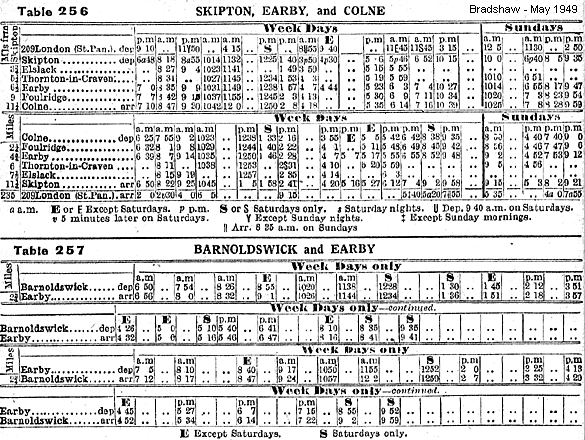
 In an attempt to stem the decline, a push-and-pull service was introduced in 1932. It was uneconomical to uncouple the locomotive after each journey on such a short branch. If the locomotive remained coupled to the carriages and pulled them to Barnoldswick and then pushed them back to Earby, savings could be made. The railway also cut fares. The Craven Heraldreported on 22 July 1932 that ‘contrary to the practice of recent years, Barnoldswick people had used the railway as the chief mode of transit throughout the holiday week’. This had been due to cheaper rates; fares for Blackpool, Morecambe and Southport had been reduced considerably. Many people had taken advantage of the new 15 shilling (75p) tourist ticket extending over the full week.
In an attempt to stem the decline, a push-and-pull service was introduced in 1932. It was uneconomical to uncouple the locomotive after each journey on such a short branch. If the locomotive remained coupled to the carriages and pulled them to Barnoldswick and then pushed them back to Earby, savings could be made. The railway also cut fares. The Craven Heraldreported on 22 July 1932 that ‘contrary to the practice of recent years, Barnoldswick people had used the railway as the chief mode of transit throughout the holiday week’. This had been due to cheaper rates; fares for Blackpool, Morecambe and Southport had been reduced considerably. Many people had taken advantage of the new 15 shilling (75p) tourist ticket extending over the full week.

 The Skipton - Colne line was indicated as part of the ‘network for development’ in March 1967, and would be the only passenger line retained to Skipton if the proposal had been followed. However the plan was reconsidered in favour of retaining the trains between Skipton and Leeds/Bradford – today an electrified commuter line with an intensive service – and, for the time being, continuing to operate trains between Skipton and both Carlisle and Lancaster as well. The closure of the Skipton to Colne route was published on 20 December 1968 and approved by the Minister of Transport on 19 December 1969; closure to passengers swiftly followed on 2 February 1970. Colne is now the terminus of the East Lancashire Line with trains running from Blackpool South run through Preston and Blackburn to Burnley and Colne. The removal of the eleven miles between Skipton, Earby and Colne is generally regarded as one of the less intelligent closure decisions, and there has long been an animated campaign to reinstate the line. The Leeds to Skipton route is part of the ‘Airedale Line’, also used by trains on the Leeds-Morecambe and Leeds, Settle and Carlisle services.
The Skipton - Colne line was indicated as part of the ‘network for development’ in March 1967, and would be the only passenger line retained to Skipton if the proposal had been followed. However the plan was reconsidered in favour of retaining the trains between Skipton and Leeds/Bradford – today an electrified commuter line with an intensive service – and, for the time being, continuing to operate trains between Skipton and both Carlisle and Lancaster as well. The closure of the Skipton to Colne route was published on 20 December 1968 and approved by the Minister of Transport on 19 December 1969; closure to passengers swiftly followed on 2 February 1970. Colne is now the terminus of the East Lancashire Line with trains running from Blackpool South run through Preston and Blackburn to Burnley and Colne. The removal of the eleven miles between Skipton, Earby and Colne is generally regarded as one of the less intelligent closure decisions, and there has long been an animated campaign to reinstate the line. The Leeds to Skipton route is part of the ‘Airedale Line’, also used by trains on the Leeds-Morecambe and Leeds, Settle and Carlisle services.

 Home Page
Home Page